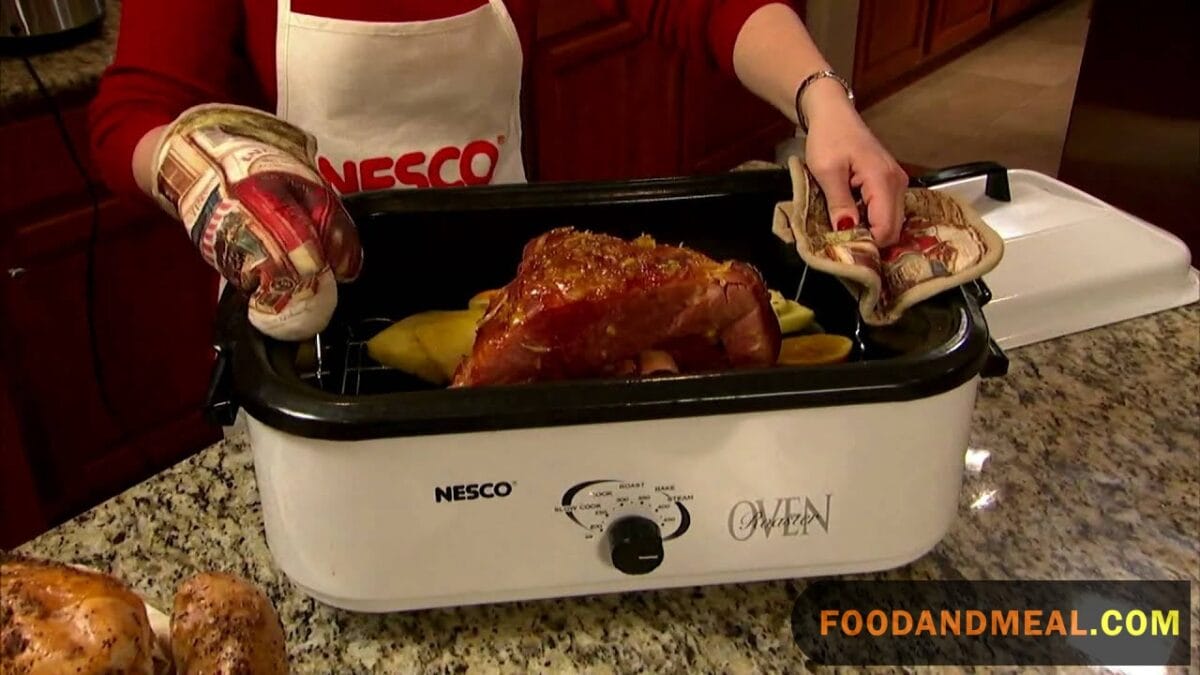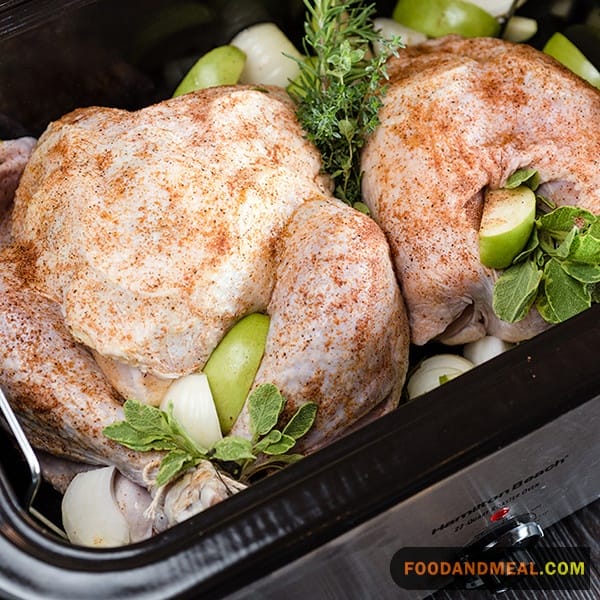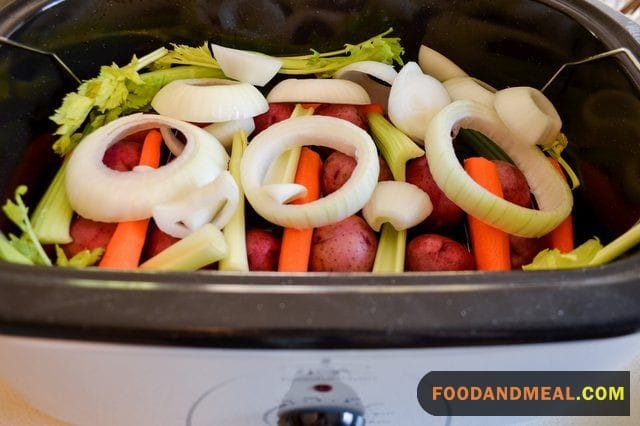If you’re seeking a method to maintain food warmth without relying on an oven, this post How to Use a Roaster Oven to Keep Food Warm of Food and Meal about provides the solution you’re looking for. A common kitchen appliance for many is the roaster oven, whether serving as the primary cooking tool or not.
These roaster ovens feature a convenient keep-warm setting, ideal for keeping food warm on the table post-cooking. Moreover, they can be preheated at 350℉ for 30 minutes and then transitioned to the warm setting. This flexibility allows you to keep food warm, even if it was prepared using a different kitchen appliance or at an earlier time.
Easy Steps to Keep Food Warm in a Roaster Oven
Are you planning to host a gathering with a buffet-style meal and want to ensure your dishes remain warm and delectable as guests come and go? Look no further than your dependable roaster oven—it’s the perfect tool for the job! Follow these comprehensive steps to effortlessly present a hot and delightful buffet experience at your next party or family function:
- Prepare Your Buffet Pans: Before you begin, make sure you have your roaster oven’s buffet pans ready for use.
- Remove the Insert Pan: Take out the insert pan from your roaster oven to create space for your buffet setup.
- Water Filling: Fill the bottom of the roaster oven with two gallons of warm water. This creates a humid environment that helps keep your dishes moist and warm.
- Buffet Server Assembly: If your roaster oven comes with a buffet server that requires assembly, assemble it above the oven as per the manufacturer’s instructions.
- Cover Up: Place the cover on top of your roaster oven to retain heat and ensure an even cooking temperature.
- Preheat Your Roaster Oven: Set the temperature knob to 350 degrees Fahrenheit and allow your roaster oven to preheat for approximately 30 minutes. This ensures a consistent and suitable cooking environment.
- Adjust the Temperature: After preheating, uncover the roaster oven and adjust the temperature down to 200 degrees Fahrenheit. This lower temperature is ideal for keeping your dishes warm without overcooking.
- Load Up the Buffet Pans: Add the hot and ready-to-serve food into your buffet pans. Place the buffet pans into the base of the roaster oven or onto the buffet server, ensuring an organized and accessible setup.
- Stirring for Consistency: To prevent the food from sticking to the buffet pans, stir the dishes every 30 minutes. Keep the lid closed during this process unless you are retrieving or adding more food to maintain optimal temperature levels.
These steps guarantee a seamless and efficient buffet service, allowing you to focus on enjoying the company of your guests. If you’re curious to learn more about roaster ovens, including tips on usage and insights into their functionality, continue reading for a deeper understanding of this versatile kitchen appliance.
What is a Roaster Oven

The pressure cooker is an ingenious cooking device that utilizes steam pressure to cook food quickly and efficiently without extremely high temperatures. Inside the sealed pot, steam from the cooking food cannot escape. The steam accumulates and creates pressure within the pot. At normal atmospheric pressure, water boils at 100°C (212°F). But with increased pressure, the boiling point of water can reach 121°C (250°F).
Although 250°F is not an extremely high temperature by cooking standards, it makes a big difference in cook times due to the faster rate of chemical reactions. The protein fibers in meat, beans, grains, and other foods break down more rapidly at the slightly elevated boiling point.
For comparison, roasting food typically uses temperatures from 350-475°F, deep frying and pressure frying use oil heated above 500°F. Stovetop cooking can also exceed 500°F at high heat.
So while the pressure cooker significantly reduces cook time, it does so at relatively low temperatures compared to other methods. The key lies in the pressurized environment, not extremely high heat. This makes the pressure cooker a fast, energy efficient, and effective way to cook.
Additionally, the pressure cooker seems to retain more nutrients compared to conventional cooking methods. Research shows pressure cooking preserves 90-95% of vitamin C and B vitamins, while boiling reduces them by 40-75%, and roasting and steaming only retain up to 90% nutrients. The shorter cook time and lower temperatures are likely the reason.
In summary, the pressure cooker cooks faster thanks to pressure, not high heat. It also retains nutrients better than boiling, steaming, or roasting. The pressure cooker is truly an intelligent and efficient way to cook.
What Can I Cook in My Roaster Oven?
While roaster ovens are commonly employed for meat dishes, they offer versatility for preparing an array of side dishes such as potatoes or impeccably seasoned rice. Additionally, they can be utilized for crafting desserts like cheesecake or other baked goods, as well as crowd-pleasers like meatballs and pasta bakes. The possibilities are diverse, allowing you to explore and create a wide range of culinary delights based on your preferences.

Can I Steam Vegetables in My Roaster Oven?
Steaming large batches of vegetables in a roaster oven is easy with the right setup. Add an inch or two of water to the bottom of the roaster oven, depending on the size. Then place a metal steaming basket or colander inside the roaster to hold the vegetables separate from the water. The steam from the heated water will cook the vegetables perfectly.
When using this steaming method, consult your specific roaster oven manual for guidance on the ideal amount of water to use for steaming. In general, around 1-2 inches of water in the bottom is sufficient.
A few tips for safe steaming:
- Use potholders when removing the lid, as steam buildup will make it very hot.
- Also use potholders or tongs when handling the basket of steamed vegetables, as the metal and vegetables will be extremely hot from the steam.
- Take care when removing the basket of cooked vegetables not to spill the hot water in the bottom.
With the right accessories like a steaming basket, roaster ovens can easily steam large batches of crisp-tender vegetables using only the power of hot steam. Just be sure to handle the hot items carefully.
Should I Always Add Water to the Bottom of My Roaster Oven?
No, unless you’re specifically steaming or aiming to maintain food warmth! Introducing water is unnecessary and counterproductive when using a roaster oven. (Always refer to the manufacturer’s instructions before employing the appliance for warming purposes).
Roasting is a dry cooking method involving high heat, and the roaster oven is explicitly designed to harness and recycle the moisture within the meat being roasted.
If you’re roasting a turkey or chicken, adding water could hinder the desired browning and crisping of the meat—exactly the opposite of what one expects from a roaster oven! Furthermore, the excess moisture might dilute the natural flavors inherent in the meat juices.
These flavorful juices are collected at the bottom of the roaster oven and then recycled. As they heat up, they undergo evaporation and ascend back to the meat, intensifying its taste.

Is a Roaster Oven Easy to Clean?
Cleaning up after cooking can be a chore, especially when dealing with messy, hard-to-wash roasting pans. However, roaster ovens make tidying up a breeze. Their removable roasting pans allow for quick and convenient cleaning since you can easily take them right to the sink. These pans are crafted to be safe for scrubbing and washing, without fear of warping or damage. Many roaster ovens even have non-stick interiors, making post-meal cleanup as simple as a quick wipe down. With a roaster oven, you can skip the hassle of scrubbing tough, baked-on residue. Simply remove the pan, give it a fast wash, and you’re done. Roaster ovens take the frustration out of cleaning up after hearty roasted meals, letting you enjoy the food without dreading the cleanup.
Whether you’re a home cook or a professional chef, incorporating a roaster oven into your kitchen is a fantastic choice. This versatile and user-friendly countertop appliance offers a myriad of cooking options, making your favorite recipes more accessible and enjoyable than ever before.
FAQs about How to Use a Roaster Oven to Keep Food Warm
1. Why use a roaster oven to keep food warm instead of other methods? A roaster oven provides a consistent and controlled temperature, making it an efficient and convenient option for keeping food warm, especially for large gatherings or events.
2. Can I use a roaster oven to keep all types of food warm? Yes, a roaster oven can effectively keep a variety of foods warm, including casseroles, roasts, side dishes, and more. It’s versatile for maintaining the temperature of different types of dishes.
3. How do I preheat a roaster oven before placing food inside? Preheat the roaster oven by setting it to the desired temperature before placing your food inside. Allow it to reach the set temperature before adding the dishes.
4. What temperature should I set the roaster oven to keep food warm? Set the roaster oven to a low or warm setting, usually around 150°F to 200°F (65°C to 93°C). This ensures that the food stays warm without overcooking or drying out.
5. Can I use a roaster oven to keep food warm for an extended period? Yes, a roaster oven is designed for extended use. The low temperature setting allows you to keep food warm for several hours without overcooking or compromising its quality.
6. How do I prevent food from drying out in the roaster oven? To prevent drying, cover the dishes with lids or aluminum foil. You can also add a bit of moisture by placing a pan of water in the bottom of the roaster oven or spritzing water over the food occasionally.
7. Can I use the roaster oven to warm multiple dishes simultaneously? Yes, the roaster oven typically has a large capacity, allowing you to warm multiple dishes at the same time. Arrange the dishes to allow for even heat distribution.
8. How do I monitor the temperature of the food in the roaster oven? Use a food thermometer to check the internal temperature of the dishes, ensuring they remain within the safe temperature range. This is especially important for meats and other perishable items.
9. What safety precautions should I take when using a roaster oven to keep food warm? Follow the manufacturer’s safety guidelines and ensure that the roaster oven is placed on a heat-resistant surface. Use oven mitts when handling hot dishes, and be cautious when opening the lid to avoid burns from steam.
I'm Kelly Atkinson, with a passion for dissecting the world of home goods. My reviews stem from thorough testing and a love for sharing detailed insights. Each piece I write offers a glimpse into my explorative journey, aiming to guide readers to informed choices with authenticity and precision, making every review a blend of exploration and expertise.
